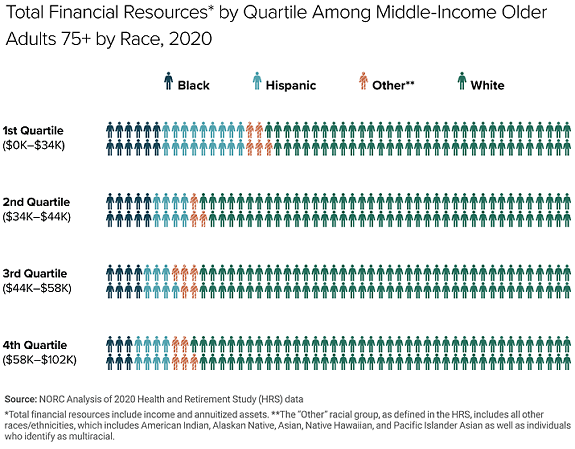Growing Number of Black & Hispanic Middle-Income Older Adults May Be Unable to Afford Housing & Health Care in the Next Decade
For Media Inquiries:
New analysis of middle-income older adults reveals financial disparities across racial and ethnic groups and geography.
CHICAGO, February 15, 2024 — Millions of Black and Hispanic middle-income older adults will lack the financial resources to pay for senior housing and health care expenses as they age, according to new findings from NORC at the University of Chicago’s “Forgotten Middle” study commissioned by The SCAN Foundation. The analysis shows the number of middle-income older adults of color will increase from 12 percent in 2020 to 25 percent by 2035, yet this population will be least likely to afford senior housing and care when compared to the middle-income older adult population as a whole.
The study points to widening gaps among Black and Hispanic middle-income older adults around home ownership, home equity, financial assets, and marriage rates compared to their white peers. This results in fewer financial resources to afford senior housing and care. Case studies and an analysis of existing literature highlight the challenges middle-income older adults may face in rural areas.
“Wealth is not distributed evenly across the Forgotten Middle. Now we know that Black and Hispanic older adults are the worst off,” said Sarah Rayel, senior director in NORC’s Health Care Strategy department. “Black and Hispanic middle-income older adults have fewer liquid assets and less equity than other middle-income older adults, which is making it harder to leverage their home to support future housing and health care needs.”
The “Forgotten Middle” consists of older adults aged 75+ who do not qualify for Medicaid but lack sufficient resources to pay for assisted living, senior housing, and future care needs as they encounter age-related physical and cognitive challenges. Consistent with previous NORC research, middle-income older adults are defined as having annuitized income and assets ranging from $26,000 to $103,000 in 2020 dollars.

Additional findings include:
- Home ownership by younger Black older adults is declining and expected to fall substantially by 2035 with Black and Hispanic homeowners projected to have lower home equity. See the accompanying Spotlight on Health for more details on the financial disparities across racial groups within the Forgotten Middle.
- Marriage rates are expected to drop below 50 percent across all racial groups, leaving those living alone at a greater risk of adverse health events and social isolation. By 2035, only a quarter of Black older adults and 40 percent of Hispanic older adults will be married.
- Black and Hispanic older adults tend to have higher rates of health complications across multiple health indicators, including chronic conditions and mobility limitations. These health complications likely increase the need for additional care.
- Middle-income older adults in rural areas may face distinct challenges in their ability to age well due to poorer health outcomes, lower financial resources, lack of support services, and workforce shortages.
“Every older adult deserves to age well with purpose regardless of economic circumstances,” said Dr. Sarita A. Mohanty, president and CEO of The SCAN Foundation. “The impending crisis facing people who won’t qualify for Medicaid and won’t be able to afford private home care will impact older adults of color much more acutely. Policymakers, as well as the healthcare and senior housing communities have substantial work to do to ensure that race does not become a hindrance to aging well.”
Methodology
The analysis is NORC’s third follow-up to its landmark 2019 Forgotten Middle study. NORC’s Health Care Strategy team used 2020 Health and Retirement Study (HRS) data to examine historically marginalized and minoritized groups1 within the middle-income older adult population. Researchers examined finances, housing, family structures, and health status—all attributes that may affect the ability to age according to one’s wishes—segmented by race and ethnicity to understand the impact of these factors across racial and ethnic groups.
This analysis relied on the Health and Retirement Study, using 2020 as a base year. NORC researchers examined individuals who were 60 and older in 2020—as they will be 75 or older in 2035. Researchers then examined demographic attributes of this group, such as gender, race, and marital status, and estimated people’s health, cognitive, and mobility status for each demographic subgroup. Data were specifically stratified by race as defined by the HRS (Black, Hispanic, Other, white) to identify trends and project future trends among older adults in historically marginalized and minoritized communities. The “Other” racial group includes all other races/ethnicities, which includes American Indian, Alaskan Native, Asian, Native Hawaiian, and Pacific Islander, as well as individuals who identify as multiracial.
In addition, researchers modeled the individual’s future financial resources starting from their actual income and assets in 2020. Assets were grown based on the historical rate of change for each type of financial resource and annuitized across an individual’s life expectancy. All key findings presented were tested and found to be statistically significant (p<.05) using SAS survey procedures and HRS complex sampling design. NORC used a combination of two-sample t-tests and Chi-squared tests of distributions where appropriate. For the full methodology, see the Appendix in the final slides.
Further, NORC included four illustrative case studies that leverage data from real respondents in the HRS to exemplify the distinct experiences that older adults across geographies might have in 2035. These case studies contextualize the data findings and allow NORC to explore the experience of rural older adults, who often face poorer health outcomes and limited access to care and housing services compared to their urban counterparts.
1 This analysis uses the term historically marginalized and minoritized groups to describe the overall study population in alignment with equitable language guidance, such as that from government agencies, medical associations, and academic institutions. The term historically marginalized and minoritized acknowledges that power structures actively marginalize certain groups, even if those groups may be the majority in some scenarios.
About NORC at the University of Chicago
NORC at the University of Chicago conducts research and analysis that decision-makers trust. As a nonpartisan research organization and a pioneer in measuring and understanding the world, we have studied almost every aspect of the human experience and every major news event for more than eight decades. Today, we partner with government, corporate, and nonprofit clients around the world to provide the objectivity and expertise necessary to inform the critical decisions facing society.
Contact: For more information, please contact Eric Young at NORC at young-eric@norc.org or (703) 217-6814 (cell).
About the SCAN Foundation
The SCAN Foundation is an independent public charity devoted to transforming care so that every older adult has the choices and opportunity to age well with purpose. For more information, visit www.TheSCANFoundation.org.


